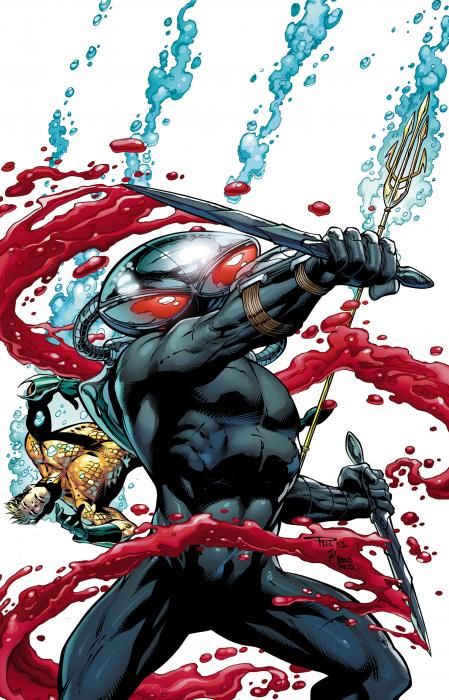In "Aquaman #23.1: Black Manta" by Tony Bedard, Geoff Johns and Claude St. Aubin, Black Manta is broken out of Belle Reve and considers his offer from the Crime Syndicate's with characteristic cold and near-silent single-mindedness.
"Aquaman" #23.1 begins in Black Manta's cell. The first three pages recap his New 52 origin, first revealed in "Aquaman" #9 and #10, as he repeats his refusal of Amanda Waller's offer to add him to the ranks of the Suicide Squad. While this recap is great for new readers picking "Aquaman" up as part of the Villains Month crossover, it's old news for regular readers. However, St. Aubin's full-page visual introduction of Black Manta is excellent, with the shadows of prison bars wrapping around Black Manta's body, tracing the direction of his facial scar.
While it's no surprise that Black Manta gets out of prison and is delivered a coin of offer from the Crime Syndicate, Bedard and St. Aubin make the prison scenes count. St. Aubin's camera angle dogs Black Manta's thoughts and movements, playing up the villain's stoicism and capacity for rapid, reactive violence. On the lighter side, the entirely silent cameo of Ocean Master and the hilariously flamboyant dialogue of King Shark are gifts to ongoing "Aquaman" readers, providing continuity and enjoyable texture to the plot.
Bedard and St. Aubin's pacing is cinematically skillful in Belle Reve and Happy Harbor, with beats of silent panels to capture Black Manta's reactions to his new freedom and to the world-changing news that Aquaman is out of the picture. His dead-eyed, cold reactions to the mingled chaos and the camaraderie within a sea of villains are chilling. He is of the group but not with them. When Black Manta later visits his father's grave, his outpouring of grief is even more poignant by contrast. St. Aubin's facial expressions and body language create a forceful emotional presence. Taking the cues from Bedard's script, St. Aubin also uses space and silence more than words to convey characterization.
Unfortunately, the emotional nuance of St. Aubin's pacing and the sharpness of Bedard's dialogue are counteracted by Johns and Bedard's overwrought plotting. Of course, "Aquaman" #23.1 is bounded by the limits of the structure of Villains Month and previously established New 52 backstory. Black Manta's raison d'etre, previously established by Johns, feels stale here. "You killed my father" is an overused trope, as its usage in tongue-in-cheek homages and parodies like "The Princess Bride" would indicate.
After the prison break, Johns and Bedard deliberately retell part of "Forever Evil" #1, but show the reader the events from Black Manta's mostly point of view. This retreading achieves its intended effect or personalizing these events around Black Manta and bringing the reader eerily closer to him. However, it also comes off as repetitive, and worse, it leaves less room in "Aquaman" #23.1 for the evolution of Black Manta's motivations in a world without Aquaman and the Justice League.
In Belle Reve and Happy Harbor, Bedard's pacing and dialogue feel just right, but events feel too speeded up after Black Manta leaves the Crime Syndicate mosh pit. The foreshadowing of the ending in the first few pages is heavy-handed. In the final scenes, it's fatalistic and contrived that Black Manta would grasp at a new purpose almost blindly. Black Manta could have realistically been shown to make this decision ultimately anyway, but having the plot involve the desecration of his father's physical grave falls short of feeling epic and instead just feels melodramatic.
In "Aquaman" #23.1, Black Manta makes a significant choice along the continuum from villain to potential antihero. Despite the low amount of new data and a superficial treatment of motivation, through St. Aubin's art and Bedard's pacing, the story succeeds at imbuing Black Manta with purpose and dignity and creating sympathy for him.

